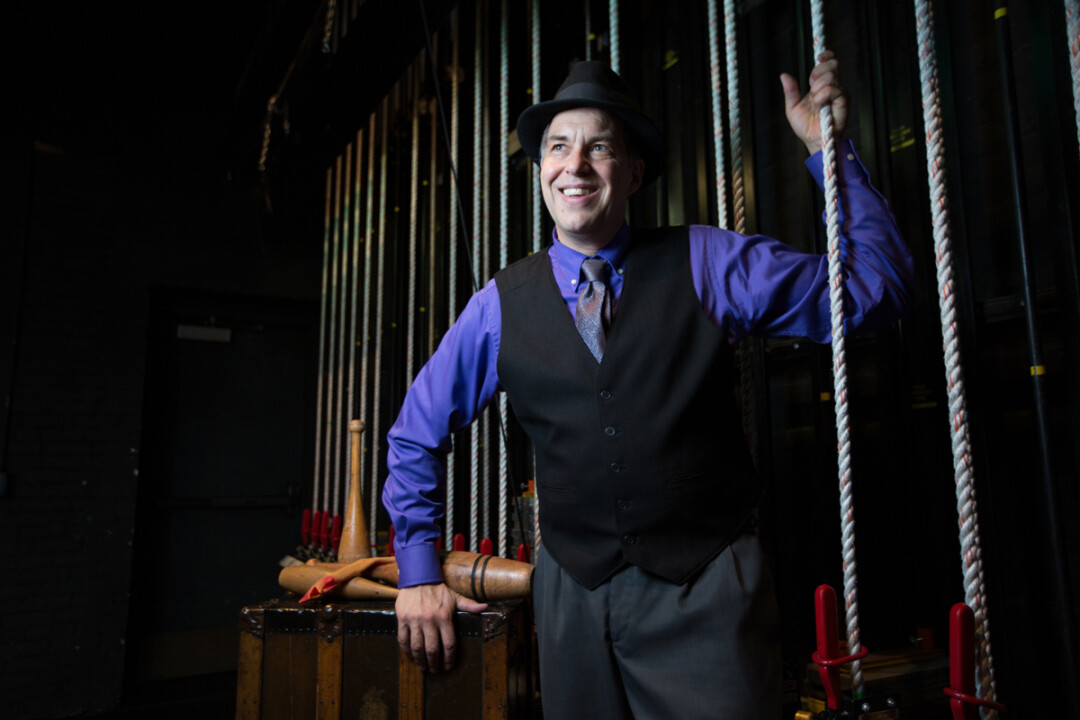Clown Theory
this year’s clown phobia is rooted in something serious
Steve Russell, photos by Travis Dewitz |

Everybody loves clowns, right? They do tricks, they twist balloons, juggle, do magic, and make people laugh. Good, right? So when, how, and why did it all go bad?
I’ve spent all of my adult life “identifying” as part of the clown universe. Even though I haven’t put on makeup in 30 years, there are still clownish elements in everything I do as a professional performer.
 Ringling Bros. Circus gave me my first real career break. I was a student (and spent two years on the faculty) of their famous Clown College. You would be hard-pressed to find a school that taxed you as physically, mentally, and emotionally as Clown College did. Believe it or not, it isn’t all seltzer bottles and cream pies. Clowning is artistically challenging, physically exhausting, and emotionally draining – if you are doing it right.
Ringling Bros. Circus gave me my first real career break. I was a student (and spent two years on the faculty) of their famous Clown College. You would be hard-pressed to find a school that taxed you as physically, mentally, and emotionally as Clown College did. Believe it or not, it isn’t all seltzer bottles and cream pies. Clowning is artistically challenging, physically exhausting, and emotionally draining – if you are doing it right.
Then, emerging from the woods, crawl the creepy clowns. And there goes all of our hard work.
I get it. Some people think clowns are scary. We can’t see their faces. What are they hiding?
Truthfully? Nothing. Makeup is not a mask, it is a magnifier. In order for clowns to make fun of the human condition, makeup is used, literally, to highlight expressions. Smiles are bigger. Sadness is intensified. Pain and surprise are shown more viscerally. It doesn’t mute the person, it exaggerates the emotion. If a clown stubs a toe, you see the pain in every part of the body.
The trope of the “clown with something to hide” is an old one. In America, it goes back to at least the 1850s. The opera Pagliacci features a murderous clown. So does the silent film He Who Gets Slapped. You’ve got American Horror Story’s Twisty, and of course Stephen King’s It capitalizing on the myth, as well. All highlight the paradox of evil lying just beneath the veneer of child-like sweetness. An ironic (and now, iconic) symbol of horror.
But. Why are we seeing intensified Bozo-phobia this year? Out of nowhere, across the country, people are donning masks and wigs and machetes – to intimidate and spook. What has brought It to the forefront now?
I have a theory.
A clown is inhuman and vaguely human at the same time. The enemy is easily identified – the painted face, the garish clothes, the red nose. There is no guesswork in our condemnation, and there is comfort in that.
We are living in a world where it is difficult to know the dangers. No black hats. No white hats. We don’t know whom to blame for our anxiety. So, we direct our fears onto something that is foreign to us, but without the stigma of racism or xenophobia. A clown is inhuman and vaguely human at the same time. The enemy is easily identified – the painted face, the garish clothes, the red nose. There is no guesswork in our condemnation, and there is comfort in that.
So, here is what you need to know about this fad:
They aren’t really clowns. Hey, if I went to the store and bought a hardhat and a hammer, you wouldn’t call me a construction worker. The same is true of someone whose only credentials are a visit to Spencer’s in the mall.
It doesn’t make sense. Now, I’m not a career criminal, but I would guess that putting on a wig that can be seen at 30 yards and donning oversized, floppy footwear is no way to conduct a crime spree. I mean, have you ever tried to run in those shoes?
Almost all of the threats are empty. Most of the “threats” we have seen in 2016 are expressed on social media sites. A warning will be posted to a school Facebook page that “clowns are coming and everyone is in danger!” And people wait. In fear. Nothing happens. We all know that the Internet is a great hideout for attention-seeking, socially inept trolls, right? Add the shield of anonymity a mask provides, and a few keystrokes is all it takes for some loser to get a school district to stop and take notice.
That brings us to the larger point: Take away the clown element of these stories, and what we are left with is anonymous people threatening our communities. But, because these tales are wrapped in the garish colors of the circus, we greet the news with a smirk and a bemused head shake. Let’s call this what it really is: domestic terrorism.
The clowns I know are serious professionals. They are among the most fun and creative people you could meet. The alumni of Clown College include Oscar, Tony and Emmy nominees – and winners. Penn Jillette (Penn and Teller), Steve-O (Jackass), David Strathairn (actor, Good Night and Good Luck), and Bill Irwin (Sesame Street’s “Mr. Noodle”) are all graduates of Clown College, and all continue to bring joy to the public.
This current phase will run its course. We may have to endure a rather tedious Halloween, however, with people attempting to be “Edgy, the Clown.” Copycats will abound, robbing the holiday of its creativity, and further tarnishing the good name of Bozos everywhere.
Don’t be fooled. This lot does not represent the state of the art. Not everyone who is called a clown can fit in the car.






















